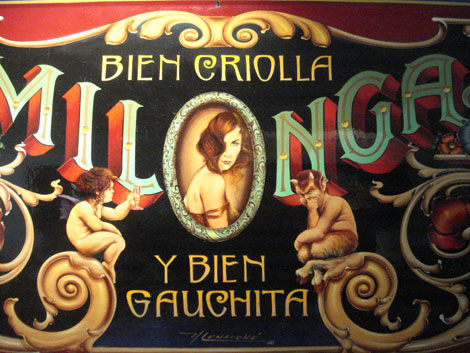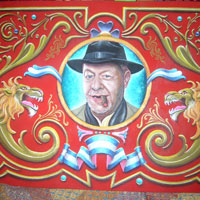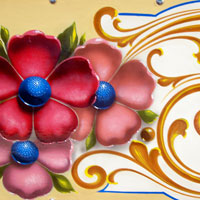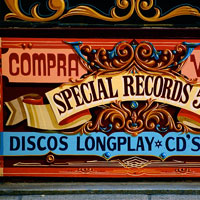
FILETEADO. What is it? Well if tango is the distinctive porteño dance, and steak-and-Malbec is the distinctive porteño meal, then fileteado is the distinctive porteño artwork. But actually, it takes a while to realize that fileteado is a distinctive style at all. That’s probably because it’s a style of artwork that decorates things – buses, cars, signs, shop windows etc. – and so it takes a back seat to what it’s decorating. You’d never see fileteado hanging in a gallery; it lives on the street.

Buenos Aires Fileteado
Fileteado is a sort of filigree style with a lot of common motifs. The common motifs are things like flowers, scrolls, leaves, ribbons, little balls and lines, both straight and curved. It combines these elements with things like rural scenes, couples dancing, and famous characters such as Carlos Gardel. It’s also very bright and colorful, traditionally painted with synthetic enamel that is highly resistant to the elements and doesn’t fade over time.
It’s hard to pinpoint the exact origins of fileteado because, just as for tango, there wasn’t one defining event or person that can be said to have begun it. However, there were a trio of Italian immigrants named Cecilio Pascarella, Vicente Brunetti and Salvador Venturo who most people agree all had a hand in creating it.

On a Pizza Store Front
Pascarella, Brunetti and Venturo all worked in factories that made carts designed to be pulled by horses (this was around the year 1900). For whatever reason they began to decorate their carts, using a style that probably came from Europe and in particular from the traditions of the Gypsies. The first people to imitate them were their own sons, but the style quickly caught on and before long fileteado art was on the carts (and before long, buses and trucks) that travelled every street of Buenos Aires.

Fileteado as Flowers
In the heyday of fileteado, colectivos (that is, city buses) were privately owned by their drivers, and so they were free to choose whatever artist and fileteado art for their vehicles they liked, resulting in a lot of very colorful buses. Maybe the drivers felt that their bus would attract more customers if it was elaborately decorated, or maybe they just liked the way it looked, in the same way that petrol-heads get their cars spray-painted with flames and other intricate designs today.

Sign of a Record Store
Today, a small band of passionate fileteadores carry on this distinctive Porteño artwork. Their artwork is particularly common in San Telmo and on El Caminito in La Boca. Stroll down Calle Defensa and pay attention and you’ll see it everywhere. There’s also a lot of it in Abasto on Jean Juares, particularly on the fronts of houses (oh and by the way, if you ever have to give that street name to a taxi driver, it’s inexplicably pronounced “Jan Johray”).


4 Comments on “Fileteado: Buenos Aires Style Artwork”
I always thougth that Jean Juares was a french name and that’s the reason for the pronunciation. By the way, it´s funny how well it sounds in your english “translation”.
Have a good time in Argentina.
Hi, do you now who pianted the first picture of Milonga bien gauchita?
thanx
Pingback: !Viva Fileteado!
Pingback: What is “fileteado”? | lvstudio blog -Spanish school in Palermo Buenos Aires. Centro de idiomas ingles, portugues, frances